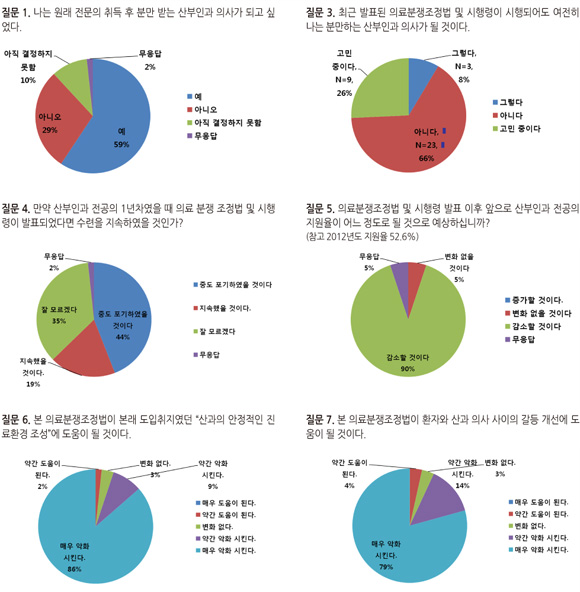Abstract
Objective
The number of resident applicants in obstetrics and gynecology in South Korea is decreasing every year. Recently, the government legislated for obstetric no-fault compensation act which obligated obstetrics and gynecology doctors to pay for 50% of the budget to compensate for the unfavorable delivery outcome that the medical provider is not responsible for. The act was faced with obstetrics and gynecology doctors' and in-trainees' resentment for putting unfair financial burden on the shoulders of the medical providers and hospitals in the absence of malpractice.In light of this, the purpose of this study was to investigate the influence of the obstetric no-fault compensation act on the future career of obstetrics and gynecology residents as obstetricians.
Methods
We conducted a survey of 4th grade obstetrics and gynecology residents (n=59) on influence of the obstetric no-fault compensation act on the future career as obstetricians through questionnaire.
Figures and Tables
References
1. Lee PS. Kang SB, editor. Adequacy of supply and demand for the hospital and the doctor by low fertility. Proceedings of the 92th Korean Society of Obstetrics and Gynecology. 2006. 2006 Sep 30 Aug 1; Seoul. Jin publishing and printing Co;95–104.
2. National Health Insurance Corporation (NHIC). Health Insurance Review & Assessment Service (HIRA). National health insurance statistical yearbook [Internet]. c2011. cited 2012 May 13. Seoul: National Health Insurance;Available from: http://www.nhic.or.kr/portal/site/main/menuitem.74b68c0b767ded38b31148b4062310a0/.
3. Ministry of Health & Welfare. Government support for the obstetrics and gynecology clinic in the area lack of delivery service in the rural area. News & notices, Feb 28, 2011 [Internet]. c2012. cited 2012 May 13. Seoul: Ministry of Health & Welfare;Available from: http://www.mw.go.kr/front/al/sal0301vw.jsp?PAR_MENU_ID=04&MENU_ID=0403&BOARD_ID=140&BOARD_FLAG=00&CONT_SEQ=249504&page=1.
4. Nelson KB. What proportion of cerebral palsy is related to birth asphyxia? J Pediatr. 1988. 112:572–574.
5. Perlman JM. Intrapartum hypoxic-ischemic cerebral injury and subsequent cerebral palsy: medicolegal issues. Pediatrics. 1997. 99:851–859.
6. Hankins GD, Speer M. Defining the pathogenesis and pathophysiology of neonatal encephalopathy and cerebral palsy. Obstet Gynecol. 2003. 102:628–636.
7. Yeargin-Allsopp M, Van Naarden Braun K, Doernberg NS, Benedict RE, Kirby RS, Durkin MS. Prevalence of cerebral palsy in 8-year-old children in three areas of the United States in 2002: a multisite collaboration. Pediatrics. 2008. 121:547–554.
8. Oh SY. Current opinion of cerebral palsy. Korean J Obstet Gynecol. 2007. 50:1191–1204.
9. Wood NS, Marlow N, Costeloe K, Gibson AT, Wilkinson AR. EPICure Study Group. Neurologic and developmental disability after extremely preterm birth. N Engl J Med. 2000. 343:378–384.
10. Grether JK, Nelson KB. Maternal infection and cerebral palsy in infants of normal birth weight. JAMA. 1997. 278:207–211.
11. Yoon BH, Park CW, Chaiworapongsa T. Intrauterine infection and the development of cerebral palsy. BJOG. 2003. 110:Suppl 20. 124–127.




 PDF
PDF ePub
ePub Citation
Citation Print
Print






 XML Download
XML Download